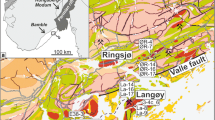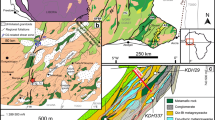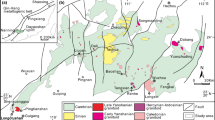Abstract
Hydrothermal tourmaline is common in the iron oxide-copper-gold (IOCG) deposits of the Coastal Cordillera of Chile where it occurs as large crystals in the groundmass of magmatic-hydrothermal breccias, such as in the Silvita or Tropezón ore bodies, or as small grains in replacive bodies or breccia cement in the ore-bearing andesite, as seen at the Candelaria or Carola deposits. Tourmaline shows strong chemical zoning and has a composition of schorl–dravite with significant povondraite and uvite components. The observed boron isotope composition is fairly variable, between −10.4‰ and +6.0‰ with no major differences among the different deposits, suggesting a common genetic mechanism. The δ11B values are significantly lower than those of seawater or marine evaporites and very similar to those of younger porphyry copper deposits and volcanic rocks in the region, indicating that the boron has a common, likely magmatic, origin. The predominant boron source was ultimately dewatering of the subducting slab with a significant contribution derived from the overlying continental basement. The range of δ11B values is between those of the porphyry copper deposits and the porphyry tin deposits of the Andes, suggesting that the IOCG mineralization might be genetically related to fluids having more crustal contamination than the porphyry copper deposits; such an interpretation is at odds with current models that propose that the Andean IOCG deposits are related to juvenile melts or to the circulation of basinal brines. Furthermore, the obtained δ11B data are markedly different from those of the tourmaline in the Carajás IOCG district (Brazil), suggesting that IOCGs do not form by a unique mechanism involving only one type of fluids.







Similar content being viewed by others
References
Audetat A, Gunther D, Heinrich CA (2000) Magmatic hydrothermal evolution in a fractionating granite: a microchemical study of the Sn-W-F-mineralized Mole Granite (Australia). Geochimica et Cosmochimica Acta 64:3373–3393
Barth S (1993) Boron isotope variations in nature: a synthesis. Geol Rundsch 82:640–651
Barton MD, Johnson DA (1996) Evaporitic source model for igneous-related Fe oxide-(REE-Cu-Au-U) mineralization. Geology 24:259–262
Barton MD, Johnson DA (2000) Alternative brine sources for Fe oxide-(Cu-Au) systems: implications for hydrothermal alteration and metals. In: Porter TM (ed), Hydrothermal Iron Oxide Copper-Gold & Related Deposits: A Global Perspective, Australian Mineral Foundation, Adelaide, v.I., pp 43–60
Bebout GE, Nakamura E (2003) Record in metamorphic tourmalines of subduction-zone devolatilization and boron cycling. Geology 31:407–410
Bebout GE, Ryan JG, Leeman WP, Bebout AE (1999) Fractionation of trace elements by subduction-zone metamorphism—effect of convergent-margin thermal evolution. Earth and Planetary Science Letters 171:63–81
Benavides J, Kyser TK, Clark AH, Oates CJ, Zamora R, Tarnovschi R, Castillo B (2007) The Mantoverde iron oxide-copper-gold district, III region, Chile: the role of regionally derived, nonmagmatic fluids in chalcopyrite mineralization. Econ Geol 102:415–440
Benton LD, Ryan JG, Tera F (2001) Boron isotope systematics of slab fluids as inferred from a serpentine seamount, Mariana forearc. Earth and Planetary Science Letters 187:273–282
Berg K, Breitkreuz C, Damm KW, Pichowiak S, Zeil W (1983) The North-Chilean Coast Range—an example for the development of an active continental margin. Geol Rundsch 72:715–731
Brown M, Diaz F, Grocott J (1993) Displacement history of the Atacama Fault System 25°00′S-27°-00′S, Northern Chile. Geol Soc Am Bull 105:1165–1174
Cembrano J, Gonzalez G, Arancibia G, Ahumada I, Olivares V, Herrera V (2005) Fault zone development and strain partitioning in an extensional strike-slip duplex: a case study from the Mesozoic Atacama fault system, Northern Chile. Tectonophysics 40:105–125
Chaussidon M, Albarède F (1992) Secular boron isotope variations in the continental crust—an ion microprobe study. Earth and Planetary Science Letters 108:229–241
Chaussidon M, Marty B (1995) Primitive boron isotope composition of the mantle. Science 269:383–386
Chiaradia M, Banks D, Cliff R, Marschik R, de Haller A (2006) Origin of fluids in iron oxide-copper-gold deposits: constraints from δ37Cl, 87S/86Sri and Cl/Br. Mineralium Deposita 41:565–573
Coira B, Davidson J, Mpodozis C, Ramos V (1982) Tectonic and magmatic evolution of the Andes of northern Argentina and Chile. Earth-Science Reviews 18:303–332
Dallmeyer RD, Brown M, Grocott J, Taylor GK, Treloar PJ (1996) Mesozoic magmatic and tectonic events within the Andean plate boundary zone, 26°–27°30′S, North Chile: constraints from 40Ar/39Ar mineral ages. J Geol Soc 104:19–40
Diaz A, Vivallo W, Jorquera R, Pizarra N (2003) Depósitos de Fe, óxidos de Fe-Cu-Au y su relación con el magmatismo del Cretácico Inferior, III Región de Atacama, Chile 10°Congreso Geológico Chileno. Concepción
Dreher AM, Xavier RP, Taylor BE, Martini SL (2008) New geologic, fluid inclusion and stable isotope studies on the controversial Igarape Bahia Cu-Au deposit, Carajás Province, Brazil. Mineralium Deposita 43:161–184
Dyar MD, Wiedenbeck M, Robertson D, Cross LR, Delaney JS, Ferguson K, Francis CA, Grew ES, Guidotti CV, Hervig RL, Hughes JM, Husler J, Leeman W, McGuire AV, Rhede D, Rothe H, Paul RL, Richards I, Yates M (2001) Reference minerals for microanalysis of light elements. Geostandarts Newsletter 25:441–463
Fauré G (1986) Principles of isotope geology. Wiley & Sons, New York, p 589
Foster GL, Pogge von Strandmann PAE, Rae JWB (2010) Boron and magnesium isotopic composition of seawater. Geochemistry Geophysics Geosystems 11, Q08015, 10 pp. doi:10.1029/2010GC003201
Frikken PH, Cooke DR, Walshe JL, Archibald D, Skarmeta J, Serrano L, Vargas R (2005) Mineralogical and isotopic zonation in the Sur-Sur tourmaline breccia, Rio Blanco-Los Bronces Cu-Mo deposit, Chile; implications for ore genesis. Econ Geol 100:935–961
Gelcich S, Davis DW, Spooner ETC (2005) Testing the apatite-magnetite geochronometer: U-Pb and 40Ar/39Ar geochronology of plutonic rocks, massive magnetite-apatite tabular bodies and IOCG mineralization in Northern Chile. Geochimica et Cosmochimica Acta 69:3367–3384
Gonfiantini R, Tonarini S, Gröning M, Adorni-Braccesi A, Al-Ammar AS, Astner M, Bächler S, Barnes RM, Bassett RL, Cocherie A, Deyhle A, Dini A, Ferrara G, Gaillardet J, Grimm J, Guerrot C, Krähenbühl U, Layne G, Lemarchand D, Meixner A, Northington DJ, Pennisi M, Reitznerová E, Rodushkin I, Sugiura N, Surberg R, Tonn S, Wiedenbeck M, Wunderli S, Xiao Y, Zack T (2003) Intercomparison of boron isotope and concentration measurements. Part II: evaluation of results. Geostandards Newsletter 27:41–57
Grocott J, Taylor GK (2002) Magmatic arc fault systems, deformation partitioning and emplacement of granitic complexes in the Coastal Cordillera, north Chilean Andes (25°30′S to 27°00′S). J Geol Soc 159:425–442
Hawthorne FC, Henry DJ (1999) Classification of the minerals of the tourmaline group. Eur J Mineral 11:201–215
Henriquez F, Dobbs FM, Espinoza S, Nystrom J, Travisany V, Vivallo W (1994) Origin of chilean magnetite-apatite ore deposits. In: 7°. Congreso Geologico Chileno 2:822–824
Henry DJ, Dutrow BL (1996) Metamorphic tourmaline and its petrologic applications. Rev Mineral Geochem 33:503–557
Henry DJ, Guidotti CV (1985) Tourmaline as a petrogenetic indicator mineral—an example from the staurolite—grade metapelites of NW Maine. Am Mineral 70:1–15
Henry DJ, Sun H, Slack JF, Dutrow BL (2008) Tourmaline in meta-evaporites and highly magnesian rocks: perspectives from Namibian tourmalines. Eur J Mineral 20:889–904
Hervig RL, Moore GM, Williams LB, Peacock SM, Holloway JR, Roggensack K (2002) Isotopic and elemental partitioning of boron between hydrous fluid and silicate melt. Am Mineral 87:769–774
Iriarte S (1993) Control estructural de la mineralización vetiforme en Mina Faride y su relación con el distrito de Sierra Gorda, región de Antofagasta. Thesis, Universidad de Chile, Santiago, Chile, p 200
Ishikawa T, Nakamura E (1993) Boron isotope systematics of marine sediments. Earth and Planetary Science Letters 117:567–580
Ishikawa T, Nakamura E (1994) Origin of the slab component in arc lavas from across arc variation of B and Pb isotopes. Nature 370:205–208
Jiang SY, Palmer MR, Slack JF, Shaw DR (1998) Paragenesis and chemistry of multistage tourmaline formation in the Sullivan Pb-Zn-Ag deposit, British Columbia. Econ Geol 93:47–67
Kasemann S, Erzinger J, Franz G (2000) Boron recycling in the continental crust of the central Andes from the Palaeozoic to Mesozoic, NW Argentina. Contrib Mineral Petrol 140:328–343
Kasemann SA, Meixner A, Erzinger J, Viramonte JG, Alonso RN, Franz G (2004) Boron isotope composition of geothermal fluids and borate minerals from salar deposits (central Andes/NW Argentina). Journal of the South American Earth Sciences 16:685–697
Klemm LM, Pettke T, Heinrich CA, Campos E (2007) Hydrothermal evolution of the El Teniente deposit (Chile): porphyry Cu-Mo ore deposition from low salinity magmatic fluids. Econ Geol 102:1021–1045
Krienitz MS, Trumbull RB, Hellmann A, Kolb J, Meyer FM, Wiedenbeck M (2008) Hydrothermal gold mineralization at the Hira Buddini gold mine, India: constraints on fluid evolution and fluid sources from boron isotopic compositions of tourmaline. Mineralium Deposita 43:421–434
Leeman WP, Sisson VB (2002) Geochemistry of boron and its implications for crustal and mantle processes. Rev Mineral Geochem 33:645–708
Leeman W, Tonarini S (2001) Boron isotopic analysis of proposed borosilicate mineral reference samples. Geostandards Newsletter 25:399–403
Lehmann B, Dietrich A, Heinhorst J, Metrich N, Mosbahm M, Palacios C, Schneider H, Wallianos A, Webster J, Winkelmann L (2000) Boron in the Bolivian tin belt. Mineralium Deposita 35:223–232
Mark G, Oliver NHS, Williams PJ (2006) Mineralogical and chemical evolution of the Ernest Henry Fe oxide-Cu-Au ore system, Cloncurry district, northwest Queensland, Australia. Mineralium Deposita 40:769–801
Marschall HR, Ludwig T (2006) Re-examination of the boron isotopic composition of tourmaline from the Lavicky Granite, Czech Republic, by secondary ion mass spectrometry: back to normal. Critical comment on “Chemical and boron isotopic compositions of tourmaline from the Lavicky leucogranite, Czech Republic” by S.-Y. Jiang et al., Geochemical Journal, 37, 545–556, 2003. Geochemical Journal 40: 631–638
Marschall HR, Korsakov AY, Luvizotto GL, Nasdala L, Ludwig T (2009) On the occurrence and boron isotopic composition of tourmaline in (ultra)high-pressure metamorphic rocks. J Geol Soc 166:801–823
Marschik R, Fontboté L (2001a) The Candelaria-Punta del Cobre iron oxide Cu-Au(−Zn-Ag) deposits, Chile. Econ Geol 96:1799–1828
Marschik R, Fontboté L (2001b) The Punta del Cobre Formation, Punta del Cobre-Candelaria area, Northern Chile. Journal of South American Earth Sciences 14:401–433
Marschik R, Fontignie D, Chiaradia M, Voldet P (2003a) Geochemical and Sr-Nd-Pb-O isotope composition of granitoids of the Early Cretaceous Copiapó Plutonic Complex (27°30′S), Chile. Journal of South American Earth Sciences 16:281–398
Marschik R, Chiaradia M, Fontboté L (2003b) Implications of Pb isotope signatures of rocks and iron oxide Cu-Au ores in the Candelaria-Punta del Cobre district, Chile. Mineralium Deposita 38:900–912
Mathur R, Marschik R, Ruiz J, Munizaga F, Leveille RA, Martin W (2002) Age of mineralization of the Candelaria Fe Oxide Cu-Au deposit and the origin of the Chilean Iron belt, based on Re-OS isotopes. Econ Geol 97:59–71
Meyer C, Wunder B, Meixner A, Romer RL, Heinrich W (2008) Boron-isotope fractionation between tourmaline and fluid: an experimental re-investigation. Contrib Mineral Petrol 156:259–267
Mpodozis C, Ramos V (1990) The Andes of Chile and Argentina. In: Erikssen GE, Cañas MT, Reinemund JA (eds) Geology of the Andes and its relationship to hydrocarbon and mineral resources, vol 11. Circum Pacific Council Energy and Mineral Resources Earth Science Series, pp 59–90
Mumin AH, Corriveau L, Somarin AK, Ootes L (2007) Iron oxide copper-gold-type polymetallic mineralization in the Contact Lake Belt, Great Bear Magmatic Zone, Northwest Territories, Canada. Explor Min Geol 16:187–208
Nakano T, Nakamura E (2001) Boron isotope geochemistry of metasedimentary rocks and tourmalines in a subduction zone metamorphic suite. Physics of the Earth and Planetary Interiors 127:233–252
Palmer MR, Slack JF (1989) Boron isotopic composition of tourmaline from massive sulfide deposits and tourmalinites. Contrib Mineral Petrol 103:434–451
Palmer MR, Swihart GH (1996) Boron isotope geochemistry: an overview. Rev Mineral Geochem 33:709–744
Pesquera A, Torres F, Gil-Crespo P, Torres-Ruiz J (2008) TOURCOMP: a program for estimating end-member proportions in tourmalines. Mineral Mag 72:1021–1034
Plank T, Langmuir CH (1998) The chemical composition of subducting sediment and its consequences for the crust and mantle. Chem Geol 145:325–394
Pollard PJ (2006) An intrusion-related origin for Cu-Au mineralization in iron oxide-copper-gold (IOGG) provinces. Mineralium Deposita 41:179–187
Rieger AA, Marschik R, Diaz M, Holzl S, Chiaradia M, Akker B, Spangenberg JE (2011) The hypogene iron oxide copper-gold mineralization in the Mantoverde District, Northern Chile. Econ Geol 105:1271–1299
Rosner M, Erzinger J, Franz G, Trumbull RB (2003) Slab-derived boron isotope signatures in arc volcanic rocks from the Central Andes and evidence for boron isotope fractionation during progressive slab dehydration. Geochemistry, Geophysics, Geosystems 4:1–25
Scheuber E, Andriessen PAM (1990) The kinematic and geodynamic significance of the Atacama fault zone, northern Chile. J Struct Geol 12:243–257
Schmitt AK, Kasemann S, Meixner A, Rhede D (2002) Boron in central Andean ignimbrites: implications for crustal boron cycles in an active continental margin. Chem Geol 183:333–347
Sillitoe RH (1976) Andean mineralization: a model for the metallogeny of convergent plate margins. In: Strong DF (ed) Metallogeny and Plate Tectonics. Geological Association of Canada Special Paper 14:59–100
Sillitoe RH (2003) Iron oxide-copper-gold deposits: an Andean view. Mineralium Deposita 38:787–812
Sillitoe RH, Sawkins FJ (1971) Geologic, mineralogic and fluid inclusion studies relating to the origin of copper-bearing tourmaline breccia pipes, Chile. Econ Geol 66:1028–1041
Slack JF, Palmer MR, Stevens BPJ, Barnes RG (1993) Origin and significance of tourmaline-rich rocks in the Broken Hill district, Australia. Econ Geol 88:505–541
Smith MP, Yardley BWD (1996) The boron isotopic composition of tourmaline as a guide to fluid processes in the southwestern England orefield: an ion microprobe study. Geochimica et Cosmochimica Acta 60:1415–1427
Spivack AJ, Edmond JM (1987) Boron isotope exchange between seawater and the oceanic crust. Geochimica et Cosmochimica Acta 51:1033–1043
Spivack AJ, Palmer MR, Edmond JM (1987) The sedimentary cycle of boron isotopes. Geochimica et Cosmochimica Acta 51:1939–1949
Stern CR, Skewes ME (1995) Miocene to present magmatic evolution at the northern end of the Andean Southern Volcanic Zone, Central Chile. Revista Sociedad Geologica Chile 22:261–272
Tagg SL, Cho H, Dyar MD, Grew ES (1999) Tetrahedral boron in naturally occurring tourmaline. Am Mineral 84:1451–1455
Taylor BE, Slack JF (1984) Tourmalines from Appalachian–Caledonian massive sulfide deposits: textural, chemical, and isotopic relationships. Econ Geol 79:1703–1726
Taylor GK, Grocott J, Popec A, Randall DE (1998) Mesozoic fault systems, deformation and fault block rotation in the Andean forearc: a crustal scale strike-slip duplex in the Coastal Cordillera of northern Chile. Tectonophysics 229:93–109
Tonarini S, Pennisi M, Adorni-Braccesi A, Dini A, Ferrara G, Gonfiantini R, Wiedenbeck M, Gröning M (2003) Intercomparison of boron isotope concentration measurements. Part I: selection, preparation and homogeneity tests of the intercomparison materials. Geostandards Newsletter 27:21–39
Tonarini S, Agostini S, Doglioni C, Innocenti F, Manetti P (2007) Evidence for serpentinite fluid in convergent margin systems: The example of El Salvador (Central America) arc lavas. Geochemistry Geophysics Geosystems 8. doi:10.1029/2006GC001508
Tornos F, Velasco F, Barra F, Morata D (2010) The Tropezón Cu-Mo-(Au) deposit, Northern Chile: the missing link between IOCG and porphyry copper systems? Mineralium Deposita 45:313–321
Vivallo W, Díaz A, Gelcich S, Lledó H (2000) Estilos y tipos de mineralización del Jurásico y Cretácico Inferior en la Cordillera de la Costa de la región de Copiapó, Chile. In: IX Congreso Geológico Chileno, vol 2, Puerto Varas, pp. 179–182
Wagner T, Mlynarczyk MSJ, Williams-Jones AE, Boyce AJ (2009) Stable isotope constraints on ore formation at the San Rafael tin-copper deposit, Southeast Peru. Econ Geol 104:223–248
Wiedenbeck M, Rhede D, Lieckefett R, Witzki H (2004) Cryogenic SIMS and its applications in the earth sciences. Appl Surf Sci 231(232):888–892
Williams P, Guoyi D, Pollard P, Broman C, Martinsson O, Wanhainen C, Mark G, Ryan CG, Mernagh T (2003) The nature of iron oxide-copper-gold ore fluids: Fluid inclusion evidence from Norbotten (Sweden) and the Cloncurry district (Australia). In: Eliopoulos,D.G., et al. (eds.), Mineral Exploration and Sustainable Development, Millpress Rotterdam, pp. 1127–1130
Williams P, Barton MD, Johnson DA, Fontboté L, Haller A, Mark G, Oliver NHS, Marschik R (2005) Iron oxide copper-gold deposits: geology, space-time distribution, and possible modes of origin. In: Hedenquist JW, Thompson JFH, Goldfarb RJ, Richards JP (eds) Economic geology—one hundredth anniversary volume. Society of Economic Geologists, Littleton, pp 371–406
Wittenbrink J, Lehmann B, Wiedenbeck M, Wallianos A, Dietrich A, Palacios A (2009) Boron isotope composition of melt inclusions from porphyry systems of the Central Andes: a reconnaissance study. Terra Nova 21:111–118
Xavier RP, Wiedenbeck M, Trumbull RB, Dreher AM, Monteiro LVS, Rhede D, Araújo CEG, Torresi I (2008) Tourmaline B-isotopes fingerprint marine evaporites as the source of high-salinity ore fluids in iron oxide copper-gold deposits, Carajás Mineral Province (Brazil). Geology 36:743–746
Acknowledgements
This study was done under the framework of project DGI-FEDER CGL2006-0378 of the Spanish Government and by internal funding of the SIMS Laboratory in Potsdam. It would not have been possible without the collaboration of Nicolae Pop (Minera Carola) and Manuel Erazo and Walter Gil (Minera Cenizas) who granted access to the mine site and assisted with petrologic interpretation of the samples. Thanks are also extended to Fernando Barra and Diego Morata (Universidad de Chile) for help on the study of the IOCG deposits. Our acknowledgement to Horst Marschall and John Slack for reviewing earlier versions of this manuscript and Bernd Lehmann for final editing.
Author information
Authors and Affiliations
Corresponding author
Additional information
Editorial handling: B. Lehmann
Rights and permissions
About this article
Cite this article
Tornos, F., Wiedenbeck, M. & Velasco, F. The boron isotope geochemistry of tourmaline-rich alteration in the IOCG systems of northern Chile: implications for a magmatic-hydrothermal origin. Miner Deposita 47, 483–499 (2012). https://doi.org/10.1007/s00126-011-0383-2
Received:
Accepted:
Published:
Issue Date:
DOI: https://doi.org/10.1007/s00126-011-0383-2




